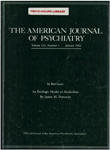The relationship between socioeconomic class and prevalence of schizophrenia, alcoholism, and affective disorders treated by inpatient care in a suburban area
Abstract
This study relates inpatient-treated prevalence of the three mental illnesses most often requiring inpatient treatment--schizophrenia, alcoholism, and affective disorders--to social class in a suburban area. Rates were developed for the total population, including those living in domiciliary care, for those living in households only, and for first-admission patients living in households. Log-linear models supported the finding that low socioeconomic status was related to a high prevalence of alcoholism and affective disorders. In contrast, socioeconomic status was not related to the prevalence of schizophrenia among those living in households or among first-admission patients living in households.
Access content
To read the fulltext, please use one of the options below to sign in or purchase access.- Personal login
- Institutional Login
- Sign in via OpenAthens
- Register for access
-
Please login/register if you wish to pair your device and check access availability.
Not a subscriber?
PsychiatryOnline subscription options offer access to the DSM-5 library, books, journals, CME, and patient resources. This all-in-one virtual library provides psychiatrists and mental health professionals with key resources for diagnosis, treatment, research, and professional development.
Need more help? PsychiatryOnline Customer Service may be reached by emailing [email protected] or by calling 800-368-5777 (in the U.S.) or 703-907-7322 (outside the U.S.).



